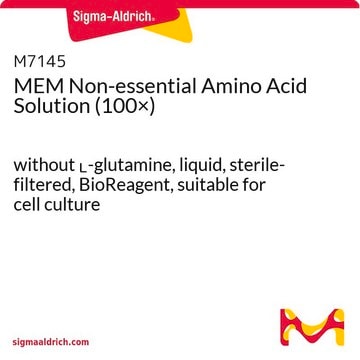Upon thawing, this solution may be aliquoted and refrozen one time for long term storage, up to the lot specific expiration date. The thawed solution is stable for up to 1 week if stored refrigerated and up to 3 days in a culture medium at 37°C.
P4333
Penicilina- Estreptomicina
liquid, non-animal origin, suitable for cell culture, BioReagent
Sinónimos:
Pluma-Strep
About This Item
Productos recomendados
Nombre del producto
Penicilina- Estreptomicina, Solution stabilized, with 10,000 units penicillin and 10 mg streptomycin/mL, 0.1 μm filtered, BioReagent, suitable for cell culture
Nivel de calidad
esterilidad
0.1 μm filtered
Línea del producto
BioReagent
Formulario
liquid
concentración
100 ×
técnicas
cell culture | mammalian: suitable
impurezas
endotoxin, tested
espectro de actividad antibiótica
Gram-negative bacteria
Gram-positive bacteria
Modo de acción
cell wall synthesis | interferes
protein synthesis | interferes
Condiciones de envío
dry ice
temp. de almacenamiento
−20°C
cadena SMILES
CC1(C)S[C@@H]2[C@H](NC(=O)Cc3ccccc3)C(=O)N2[C@H]1C(O)=O.CNC[C@H]4[C@H](O)[C@@H](O)[C@H](CCO)O[C@H]4O[C@H]5[C@@H](O[C@@H](C)C5(O)C=O)O[C@H]6[C@H](O)[C@@H](O)[C@H](NC(N)=N)[C@@H](O)[C@@H]6NC(N)=N
InChI
1S/C23H43N7O12.C16H18N2O4S/c1-7-23(38,6-32)18(42-19-8(5-28-2)12(33)13(34)9(40-19)3-4-31)20(39-7)41-17-11(30-22(26)27)14(35)10(29-21(24)25)15(36)16(17)37;1-16(2)12(15(21)22)18-13(20)11(14(18)23-16)17-10(19)8-9-6-4-3-5-7-9/h6-20,28,31,33-38H,3-5H2,1-2H3,(H4,24,25,29)(H4,26,27,30);3-7,11-12,14H,8H2,1-2H3,(H,17,19)(H,21,22)/t7-,8-,9-,10+,11-,12-,13-,14+,15-,16+,17+,18-,19-,20-,23+;11-,12+,14-/m01/s1
Clave InChI
KMOOCZWLFBSQCW-XFOLRDBHSA-N
¿Está buscando productos similares? Visita Guía de comparación de productos
Descripción general
Aplicación
La disolución de penicilina-estreptomicina se ha utilizado como suplemento en diferentes tipos de medios: en los cultivos de RGC (células ganglionares retinianas)[3]en el medio de crecimiento α-MEM (medio esencial mínimo),[4]en el medio Eagle modificado de Dulbecco/mezcla de nutrientes F-12 Ham,[5]en DMEM[6] y en DMEM/F-12 + GlutaMax.[7]
Componentes
Otras notas
Opcional
Código de clase de almacenamiento
12 - Non Combustible Liquids
Clase de riesgo para el agua (WGK)
WGK 2
Punto de inflamabilidad (°F)
Not applicable
Punto de inflamabilidad (°C)
Not applicable
Elija entre una de las versiones más recientes:
Certificados de análisis (COA)
¿No ve la versión correcta?
Si necesita una versión concreta, puede buscar un certificado específico por el número de lote.
¿Ya tiene este producto?
Encuentre la documentación para los productos que ha comprado recientemente en la Biblioteca de documentos.
Los clientes también vieron
Protocolos
Detailed procedure for how to perform a lentiviral transduction of MISSION shRNA lentiviral particles to achieve a stable long term silencing and phenotypic change.
Detailed procedure for how to perform a lentiviral transduction of MISSION shRNA lentiviral particles to achieve a stable long term silencing and phenotypic change.
Detailed procedure for how to perform a lentiviral transduction of MISSION shRNA lentiviral particles to achieve a stable long term silencing and phenotypic change.
Detailed procedure for how to perform a lentiviral transduction of MISSION shRNA lentiviral particles to achieve a stable long term silencing and phenotypic change.
Contenido relacionado
Learn how to use our cell culture tested, ready-to-use MilliShot™ single dose antibiotic solutions, conveniently packaged in one-time use vials.
Learn how to use our cell culture tested, ready-to-use MilliShot™ single dose antibiotic solutions, conveniently packaged in one-time use vials.
Learn how to use our cell culture tested, ready-to-use MilliShot™ single dose antibiotic solutions, conveniently packaged in one-time use vials.
Learn how to use our cell culture tested, ready-to-use MilliShot™ single dose antibiotic solutions, conveniently packaged in one-time use vials.
-
How long can you store Pen/Strep: cat No.P4333 at 4C?
1 answer-
Helpful?
-
-
Is it possible to thaw it before use by taking it out of the -20°C storage? If so, what is the recommended method for thawing?
1 answer-
It is best to aliquot it, keep the stock at -20°C, and take out the needed amount, leaving it in the fridge (4°C) overnight for use the next day. Warming it before use in a warm water bath is not recommended.
Helpful?
-
-
Do you label any products as GMP compliant?
1 answer-
Product P4333 is not GMP. The penicillin-streptomycin products currently offered are supplied for research and development applications.
Helpful?
-
Active Filters
Nuestro equipo de científicos tiene experiencia en todas las áreas de investigación: Ciencias de la vida, Ciencia de los materiales, Síntesis química, Cromatografía, Analítica y muchas otras.
Póngase en contacto con el Servicio técnico









